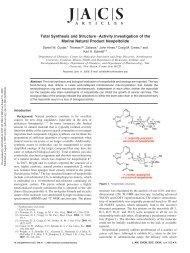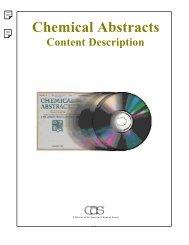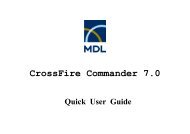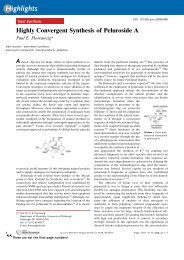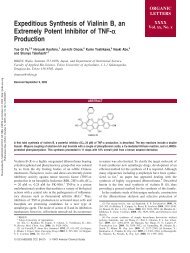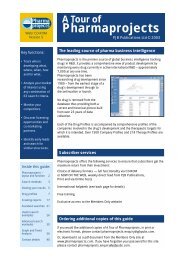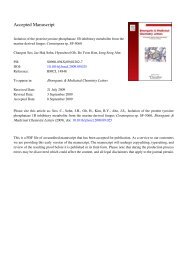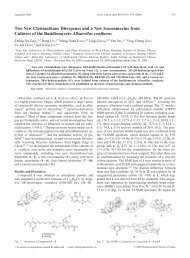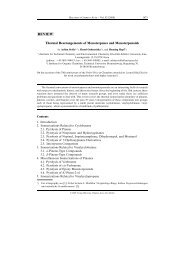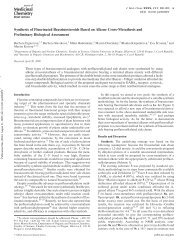Accepted Manuscript
Accepted Manuscript
Accepted Manuscript
You also want an ePaper? Increase the reach of your titles
YUMPU automatically turns print PDFs into web optimized ePapers that Google loves.
<strong>Accepted</strong> <strong>Manuscript</strong><br />
First stereoselective synthesis of synargentolide A and revision of absolute ster‐<br />
eochemistry<br />
Gowravaram Sabitha, Peddabuddi Gopal, C. Nagendra Reddy, J.S. Yadav<br />
PII: S0040-4039(09)01675-X<br />
DOI: 10.1016/j.tetlet.2009.08.109<br />
Reference: TETL 36561<br />
To appear in: Tetrahedron Letters<br />
Received Date: 11 August 2009<br />
Revised Date: 26 August 2009<br />
<strong>Accepted</strong> Date: 30 August 2009<br />
Please cite this article as: Sabitha, G., Gopal, P., Reddy, C.N., Yadav, J.S., First stereoselective synthesis of<br />
synargentolide A and revision of absolute stereochemistry, Tetrahedron Letters (2009), doi: 10.1016/j.tetlet.<br />
2009.08.109<br />
This is a PDF file of an unedited manuscript that has been accepted for publication. As a service to our customers<br />
we are providing this early version of the manuscript. The manuscript will undergo copyediting, typesetting, and<br />
review of the resulting proof before it is published in its final form. Please note that during the production process<br />
errors may be discovered which could affect the content, and all legal disclaimers that apply to the journal pertain.
ACCEPTED MANUSCRIPT<br />
First stereoselective synthesis of synargentolide A and<br />
revision of absolute stereochemistry<br />
Gowravaram Sabitha,* Peddabuddi Gopal, C. Nagendra Reddy and J. S. Yadav<br />
Organic Division I, Indian Institute of Chemical Technology, Hyderabad 500 007, India<br />
Abstract: The first stereoselective total synthesis of synargentolide A isolated from Syncolostemon argenteus has been<br />
achieved from commercially available (R)-benzyl glycidyl ether using Sharpless asymmetric epoxidation and crossmetathesis<br />
reactions as the key steps. Comparing the spectral data of the synthesized and naturally occurring synargentolide<br />
A, the C4' and C6'- stereogenic centers of the natural synargentolide A was assigned a corrected anti relationship.<br />
Naturally isolated 6-substituted-α,β-unsaturated-δ-lactones gained great attention of researcher due to<br />
their cytotoxic and anti-tumor properties. 1 In addition they inhibit HIV protease, 2 induce apoptosis, 3,4<br />
and have proven to be anti-leukemic, 5 along with having many other relevant pharmacological<br />
properties. 6 Synargentolide A (1), 7 spicegerolide (2), 8 hyptolide (3), 9 synrotolide (4) 10 and anamarine<br />
(5) 11 isolated from Syncolostemon and Hyptis species are examples of α,β-unsaturated -lactones<br />
(Figure 1). Due to their pharmacological properties, these molecules became the interesting synthetic<br />
goals. The structure of synargentolide A was proposed to be 1 by Davies-Coleman and Rivett 7 on the<br />
basis of spectroscopic findings, Mosher ester analysis and acetonide formations. Alberto Marco et al 12<br />
synthesized the published structure of synargentolide A 1 and found that spectroscopic data of the<br />
synthetic product did not match with those reported for the natural product and therefore stated that the<br />
proposed structure for the synargentolide A 1 differs from the actual one.<br />
As a part of our current interest in naturally occuring, pharmacologically active δ-lactones, 13 we<br />
became interested in the synthesis of synargentolide A and to determine the absolute configuration of<br />
the natural product.<br />
6'<br />
OAc<br />
OAc<br />
OAc<br />
5'<br />
4'<br />
OAc<br />
OAc<br />
OAc<br />
3'<br />
2'<br />
OAc<br />
1'<br />
published structure of<br />
synargentolide A 1<br />
6<br />
O<br />
5<br />
1 2<br />
O<br />
O<br />
4<br />
3<br />
O<br />
OAc<br />
OAc<br />
Keywords: -lactones, cross-metathesis, Sharpless epoxidation, lithium acetylide, revision<br />
*Corresponding author Tel.: +91-40-27191629; fax: +91-40-27191629; e-mail: gowravaramsr@yahoo.com<br />
OAc<br />
OAc<br />
OAc<br />
OAc<br />
4 5<br />
OAc OAc<br />
O O<br />
OAc<br />
2 3<br />
OAc<br />
OAc O<br />
O<br />
Figure 1. Polyoxygenated lactones<br />
6'<br />
OAc<br />
OAc<br />
5'<br />
4'<br />
OAc<br />
3'<br />
2'<br />
revised structure of<br />
synargentolide A 6<br />
1'<br />
6<br />
O<br />
O<br />
5<br />
1 2<br />
O<br />
O<br />
4<br />
3<br />
1
ACCEPTED MANUSCRIPT<br />
The retrosynthesis is outlined in Scheme 1. The target molecule 1 (published structure) 7 and 6 (revised<br />
structure) could be prepared independently by cross-metathesis reaction of 8a and 8b with vinyl<br />
lactone 7. The substrates 8a and 8b inturn could be obtained from the commercially available (R)benzyl<br />
glycidyl ether 12 by sequential reactions.<br />
Scheme 1. Retrosynthetic analysis for the published and revised structures of synargentolide A<br />
The synthesis began with commercially available (R)-benzyl glycidyl ether 12 (Scheme 2).<br />
Accordingly the ring opening of epoxide 12 with lithium acetylide ethylene diamine complex provided<br />
chiral homopropargyl alcohol 13 in 92% yield. The secondary hydroxyl group in compound 13 was<br />
protected as its MOM ether 14 using MOMCl and Hunig’s base and subsequent removal of benzyl<br />
group furnished alcohol 11. Oxidation of 11 using IBX in DMSO/DCM gave the corresponding<br />
aldehyde 15, which was subjected to a Wittig reaction with the stable ylide to afford α,β-unsaturated<br />
ester 16. After reduction of 16 to allylic alcohol 17 (75%) using DIBAL-H, Sharpless asymmetric<br />
epoxidation delivered epoxy alcohol 18 in 98% yield as a single diastereomer, which was elaborated to<br />
allylic alcohol 10 by an iodination/reductive ring-opening sequence.<br />
Epoxidation of the terminal double bond in 10 using m-CPBA provided an inseparable mixture of<br />
epoxy alcohol 20a in a ratio of 1:1 (92% combined yield). After protection of secondary hydroxyl<br />
group as benzyl ether, the resulting compound 20b was treated with LAH to give an alcohol again as an<br />
inseparable mixture (21). The MOM group was deprotected and a 1,3-diol function in compound 21<br />
was protected as acetonide by 2,2-dimethoxypropane in the presence of PPTS and the resulting<br />
acetonides 9a and 9b were easily separable by flash chromatography. In order to confirm the relative<br />
configuration of 1,3-acetonides 9a and 9b, 13 C NMR chemical shifts were studied. The two methyl<br />
groups in the acetonide part in 9a resonated at 19.0, 29.6 ppm indicating that the two hydroxyl groups<br />
are in a 1,3-syn orientation and further substantiated by the appearance of the quaternary carbon in the<br />
down field region (98.8 ppm). 14 In contrast, for the acetonide derivative 9b signals were found at 24.8,<br />
23.8 ppm and quaternary carbon at 100.7 ppm, which were characteristic for the methyl groups in the<br />
acetonide part of 1,3-anti diol. 14<br />
.<br />
OAc<br />
O<br />
OAc OAc<br />
OAc OAc O<br />
O<br />
+<br />
1 O<br />
7<br />
OAc<br />
8a<br />
OAc<br />
OAc<br />
OAc<br />
OMOM<br />
OH<br />
O<br />
O<br />
O<br />
OMOM<br />
OH<br />
O<br />
OBn<br />
O O<br />
OAc<br />
OBn<br />
6 O<br />
7 8b 9b<br />
OAc<br />
OAc<br />
10 11 12<br />
+<br />
9a<br />
+<br />
OBn<br />
O O<br />
2
O<br />
12<br />
ACCEPTED MANUSCRIPT<br />
OBn<br />
a, b<br />
OR<br />
OBn<br />
c, d<br />
OMOM<br />
R<br />
e<br />
13 R = H<br />
14 R = MOM<br />
11 R = CH2OH 15 R = CHO<br />
OMOM<br />
f OMOM g, h<br />
CO Et 2<br />
OH<br />
16 17<br />
OMOM<br />
OMOM<br />
O<br />
i j k<br />
l, m<br />
OMOM<br />
O<br />
18 R = OH<br />
19 R = I<br />
MOMO<br />
OH<br />
10<br />
OH<br />
20 OR<br />
OBn<br />
21<br />
O<br />
9a<br />
O<br />
OBn<br />
+<br />
20a R = H<br />
20b R = Bn<br />
O O<br />
Scheme 2. reagents and conditions: (a) ≡ Li, DMSO, 0 o C-rt, 1h, 92%; (b) DIEA, MOM-Cl, 2h, 0 o C-rt, 95%; (c) Li/Liq<br />
NH3, –33 o C, anhydrous THF, 0.5h, 90%; (d) IBX, DMSO, anhydrous CH2Cl2, 0 o C-rt, 24h, 95%; (e) PPh3=CHCO2Et, Ph-<br />
H, rt, 2h, 85%; (f) DIBAL-H, anhydrous CH2Cl2, –20 o C, 1h, 75%; (g) L-(+) DIPT, Ti(O i Pr)4, cumenehydroperoxide,<br />
anhydrous CH2Cl2, –24 o C, 4h, 98%; (h) TPP, I2, imidazole, Et2O/CH3CN, (3:1) 0 o C-rt, 20 min 92%; (i) Zn dust, EtOH,<br />
reflux, 2h, 92%; (j) (a) m-CPBA, NaHCO3, anhydrous CH2Cl2, –10 o C, 10h, 92%, dr (1:1); (b) BnBr, NaH, anhydrous THF,<br />
0 o C-rt, 3h, 95%; (k) LiAlH4, anhydrous THF, 0 o C-rt, 0.5h, 95%; (l) 2N HCl, rt, 5h, 93%; (m) 2,2-DMP, PPTS, anhydrous<br />
CH2Cl2, 0 o C-rt, 1h, 95%;<br />
To determine the correct absolute configuration of natural synargentolide A, both isomers of<br />
synargentolide A 1 and 6 were synthesized by the following steps from 9a and 9b as shown in Scheme<br />
3.<br />
Removal of benzyl and acetonide groups, followed by acetylation of the three hydroxy groups was<br />
performed to provide 22a in 95% yield (Scheme 3). The terminal triple bond was reduced partially to<br />
double bond under Lindlar’s conditions to afford 8a. Finally, the cross-metathesis reaction between 8a<br />
and vinyl lactone 7 13j was smoothly performed using Grubbs’ second generation catalyst to give the<br />
published structure of synargentolide A 1 (Figure 2). This did not turn out to be identical with the<br />
natural product but matched with the synthesized. 12<br />
In a similar fashion, synthesis of 6 was commenced from 9b (Scheme 3) independently repeating the<br />
steps as in the case of 1 and the target molecule 6 was obtained in good yield. The spectral properties<br />
(Figure 2) and optical rotation of the synthetic compound 6 were found to be identical with those<br />
published for the natural synargentolide A 1 {[α] 25 D = +36.5 (c = 1, CHCl3), lit. 7 [α] 25 D = +40 (c = 1.1,<br />
CHCl3)}. Therefore, the natural product structure stands revised to be 6.<br />
9b<br />
OBn<br />
R<br />
3
ACCEPTED MANUSCRIPT<br />
Scheme 3. reagents and conditions: (a) (i) Li/Liq NH3, anhydrous THF, -33 o C, 0.5h, 91%; (ii) MeOH, 2N HCl, rt, 1h, 93%;<br />
(iii) Ac2O, TEA, DMAP, anhydrous CH2Cl2, 0 o C-rt, 0.5h, 94%; (b) Pd/CaCO3, quinoline, HPLC-EtOAc, rt, 2h, 92%; (c)<br />
Gr-II, refluxing anhydrous CH2Cl2, 2h, 65%.<br />
In conclusion, we have performed a stereoselective synthesis of the natural synargentolide A and<br />
shown it to be 6. 15 Synargentolide A is therefore 6R[4R,5R,6R-triacetyloxy-1E-heptenyl]-5,6-dihydro-<br />
2H-pyran-2-one. Sharpless asymmetric epoxidation (SAE) and cross-metathesis (CM) are the key<br />
reactions involved.<br />
Acknowledgements. P.G thanks CSIR and C.N.R thanks UGC, New Delhi for the award of<br />
fellowships. We thank Dr. Michael T. Davies-Coleman, Department of Chemistry, Rhodes<br />
University, Grahamstown 6140, South Africa for sending the 1 H and 13 C NMR spectra of the natural<br />
product synargentolide A.<br />
References<br />
9a<br />
O<br />
9b<br />
O<br />
OBn<br />
O O<br />
OBn<br />
a<br />
a<br />
OAc<br />
OAc<br />
22a<br />
OAc<br />
22b OAc<br />
OAc<br />
OAc<br />
1. Hoffmann, H. M. R.; Rabe, J. Angew. Chem., Int. Ed. 1985, 24, 94-110.<br />
2. (a) Romines, K. R.; Chrusciel, R. A. Curr. Med. Chem. 1995, 2, 825–838; (b) Aristoff, P. A. Drugs Future 1998, 23, 995–999;<br />
(c) Hagen, S. E.; Vara-Prasad, J. V. N.; Tait, B. D. Adv. Med. Chem. 2000, 5, 159–195; (d) Hagen, S. E.; Domagala, J. M.;<br />
Gajda, C.; Lovdahl, M.; Tait, B. D.; Wise, E.; Holler, T.; Hupe, D.; Nouhan, C.; Urumov, A.; Zeikus, G.; Zeikus, E.; Lunney, E.<br />
A.; Pavlovsky, A.; Gracheck, S. J.; Saunders, J. M.; VanderRoest, S.; Brodfuehrer, J. J. Med. Chem. 2001, 44, 2319–2332; (e)<br />
Agrawal, V. K.; Singh, J.; Mishra, K. C.; Khadikar, P. V.; Jaliwala, Y. A. ARKIVOC 2006, 162–177.<br />
3. (a) Inayat-Hussain, S. H.; Annuar, B. O.; Din, L. B.; Taniguchi, N. Toxicol. Lett. 2002, 131, 153–159; (b) Inayat-Hussain, S. H.;<br />
Annuar, B. O.; Din, L. B.; Ali, A. M.; Ross, D. Toxicol. in Vitro 2003, 17, 433–439; (c) Chan, K. M.; Rajab, N. F.; Ishak, M. H.<br />
A.; Ali, A. M.; Yusoff, K.; Din, L. B.; Inayat-Hussain, S. H. Chem.-Biol. Interact. 2006, 159, 129–140.<br />
4. For further literature related to this important biological property, see, for example: (a) Blatt, N. B.; Glick, G. D. Bioorg. Med.<br />
Chem. 2001, 9, 1371–1384; (b) Huang, Z. W. Chem. Biol. 2002, 9, 1059–1072.<br />
5. Kikuchi, H.; Sasaki, K.; Sekiya, J.; Maeda, Y.; Amagai, A.; Kubohara, Y.; Ohsima, Y. Bioorg. Med. Chem. 2004, 12, 3203–<br />
3214.<br />
6. See, for example: (a) Stampwala, S. S.; Bunge, R. H.; Hurley, T. R.; Willmer, N. E.; Brankiewicz, A. J.; Steinman, C. E.;<br />
Smitka, T. A.; French, J. C. J. Antibiot. 1983, 36, 1601–1605; (b) Nagashima, H.; Nakamura, K.; Goto, T. Biochem. Biophys.<br />
Res. Commun. 2001, 287, 829–832; (c) Raoelison, G. E.; Terreaux, C.; Queiroz, E. F.; Zsila, F.; Simonyi, M.; Antus, S.;<br />
Randriantsoa, A.; Hostettmann, K. Helv. Chim. Acta 2001, 84, 3470–3476; (d) Lewy, D. S.; Gauss, C.-M.; Soenen, D. R.;<br />
Boger, D. L. Curr. Med. Chem. 2002, 9, 2005–2032; (e) Larsen, A. K.; Escargueil, A. E.; Skladanowski, A. Pharmacol. Ther.<br />
2003, 99, 167–181; (f) Richetti, A.; Cavallaro, A.; Ainis, T.; Fimiani, V. Immunopharmacol. Immunotoxicol. 2003, 25, 441–<br />
449; (g) Koizumi, F.; Ishiguro, H.; Ando, K.; Kondo, H.; Yoshida, M.; Matsuda, Y.; Nakanishi, S. J. Antibiot. 2003, 56, 603–<br />
609.<br />
b<br />
b<br />
8a<br />
8b<br />
OAc<br />
OAc<br />
OAc<br />
OAc<br />
OAc<br />
OAc<br />
O<br />
O<br />
c, 7<br />
O<br />
c, 7<br />
O<br />
1<br />
6<br />
4
ACCEPTED MANUSCRIPT<br />
7. Collett, L. A.; Davies-Coleman, M. T.; Rivett, D. E. A. Phytochemistry 1998, 48, 651-656.<br />
8. Pereda-Miranda, R.; Fragoso-Serrano, M.; Cerda-García-Rojas, C. M. Tetrahedron 2001, 57, 47-53.<br />
7.0<br />
7.0<br />
6.5<br />
6.5<br />
6.0<br />
OAc<br />
OAc<br />
5.5<br />
OAc<br />
5.0<br />
A<br />
published structure of<br />
synargentolide A 1<br />
OAc<br />
6.0<br />
OAc<br />
5.5<br />
OAc<br />
5.0<br />
4.5<br />
B<br />
revised structure of<br />
syn argen to lid e A 6<br />
4.5<br />
4.0<br />
O<br />
4.0<br />
O<br />
O<br />
O<br />
3.5<br />
3.5<br />
3.0<br />
3.0<br />
2.5<br />
2.5<br />
2.0<br />
2.0<br />
1.5<br />
1.5<br />
1.0<br />
1.0<br />
0.5<br />
0.5<br />
0.0<br />
0.0<br />
5
ACCEPTED MANUSCRIPT<br />
C<br />
Figure 2: Comparison of the 1 H-NMR spectra of the synthetic lactones 1 (A) and 6 (B) with that of natural<br />
synargentolide A (C)<br />
9. Achmad, S. A.; Høyer, T.; Kjær, A.; Makmur, L.; Norrestam, R. Acta Chem. Scand. 1987, 41B, 599-609.<br />
10. Coleman, M. T. D.; English, R. B.; Rivett, D. E. A. Phytochemistry 1987, 26, 1497-1499.<br />
11. Alemany, A.; Márquez, C., Pascual, C.; Valverde, S.; Martínez-Ripoll, M.; Fayos, J.; Perales, A. Tetrahedron Lett.<br />
1979, 20, 3583-3586.<br />
12. García-Fortanet, J.; Murga, J.; Carda, M.; Marco, J.A. ARKIVOC 2005 (ix), 175-188.<br />
13. (a) Sabitha, G.; Sudhakar, K.; Reddy, N. M.; Rajkumar, M.; Yadav, J. S. Tetrahedron Lett. 2005, 46, 6567-6570.<br />
b) Sabitha, G.; Narjis, F.; Swapna, R.; Yadav, J. S. Synthesis 2006, 17, 2879-2884. c) Sabitha, G.; Reddy, E. V.;<br />
Yadagiri, K.; Yadav, J. S. Synthesis 2006, 19, 3270-3274. d) Sabitha, G.; Sudhakar, K.; Yadav, J. S. Tetrahedron<br />
Lett. 2006 47, 8599-8602. e) Sabitha, G.; Bhaskar, V.; Yadav, J. S. Tetrahedron Lett. 2006 47, 8179-8181. f)<br />
Sabitha, G.; Swapna, R.; Reddy, E. V.; Yadav, J. S. Synthesis 2006 24, 4242-4246. g) Sabitha, G.; Sudhakar, K.;<br />
Yadav, J. S. Synthesis 2007 705. (h) Sabitha, G.; Bhaskar, V.; Yadav, J. S. Synth. Commun., 2008, 38, 1-12. (i)<br />
Sabitha, G.; Bhaskar, V.; Reddy, S, S.; Yadav, J. S. Tetrahedron 2008, 64(44), 10207-10213. (j) Sabitha, G.;<br />
Narjis, F.; Gopal, P.; Reddy, C, N.; Yadav, J, S. Tetrahedron: Asymmetry 2009, 20, 184-191. (k) Total synthesis of<br />
(+)-(6R,2’S)-cryptocaryalactone and diastereoisomer of (+)-strictifolione using RCM and CM; Sabitha, G.;<br />
Bhaskar, V.; Reddy, S. S and Yadav, J. S. Helv. Chim. Acta 2009 in press. (l) Sabitha, G.; Gopal, P and Yadav, J,<br />
S. Tetrahedron: Asymmetry 2009, 20, 1493-1499. (m) Total synthesis of (+)-dodoneine and its 6-epimer; Sabitha,<br />
G.; Bhaskar, V.; Reddy, S. S and Yadav, J. S. Synthesis 2009 in press. (n) A concise and efficient synthesis of<br />
(5R,7S)-kurzilactone and its (5S,7R)-enantiomer using Mukaiyama aldol reaction; Sabitha, G.; Gopal, P.; Reddy,<br />
C, N.; Yadav, J, S. Synthesis 2009 in press.<br />
14. (a) Rhychnovsky, S. D. and Skalitzky, D. J. Tetrahedron Lett. 1990 31, 945. (b) Evans, D. A.; Rieger, D. L. and<br />
Gage, J. R. Tetrahedron Lett. 1990 31, 7099.<br />
6
ACCEPTED MANUSCRIPT<br />
15. Analytical data of all the new compounds are given bellow<br />
Compound 1: [α] 25 D = +12.5 (c = 1, CHCl3); IR (KBr) 1738, 1374, 1221, 1024 cm -1 ; 1 H NMR (400 MHz, CDCl3):<br />
δ 6.84 (ddd, J = 8.8, 4.0, 2.4 Hz, 1H), 6.02 (dt, J = 10.4, 2.4 Hz, 1H), 5.75-5.63 (m, 2H), 5.15 (m, 1H), 5.08 (dt, J =<br />
7.2, 4.0 Hz, 1H, CH), 4.96 (m, 1H, CH), 4.86 (m, 1H, CH), 2.39 (m, 2H, CH2), 2.28 (m, 2H, CH2), 2.12 (s, 3H,<br />
CH3), 2.04 (s, 3H, CH3), 2.0 (s, 3H, CH3), 1.18 (d, J = 6,4 Hz, 3H, CH3); 13 CNMR (75 MHz, CDCl3): δ 170.2,<br />
170.1, 170.0, 163.8, 144.5, 130.9, 128.3, 121.5, 77.2, 73.7, 69.6, 69.3, 34.0, 29.5, 21.0, 20.8, 20.7, 16.0; HRMS<br />
calcd for C18H24O8Na: 391.1368; found: 391.1355.<br />
Compound 8a: [α] 25 D = +1.5 (c = 1, CHCl3); IR (KBr) 1742, 1370, 1216 cm -1 ; 1 H NMR (300 MHz, CDCl3): δ 5.66<br />
(m, 1H), 5.30-4.93 (m, 5H), 2.35-2.14 (m, 2H), 2.06 (s, 3H, CH3), 2.01 (s, 3H, CH3), 1.99 (s, 3H, CH3), 1.15 (d, J<br />
= 6.0 Hz, 3H, CH3); 13 CNMR (75 MHz, CDCl3): δ 170.1, 170.0, 169.9, 132.0, 118.8, 74.2, 70.2, 68.7, 35.3, 121.0,<br />
20.8, 20.6, 16.3.<br />
Compound 8b: [α] 25 D = +22.5 (c = 1, CHCl3); IR (KBr) 1744, 1372, 1222 cm -1 ; 1 H NMR (400 MHz, CDCl3): δ<br />
5.69 (m, 1H), 5.16 (dt, J = 7.0, 3.1 Hz, 1H, CH), 5.11-5.03 (m, 3H), 4.94 (m, 1H, CH), 2.24 (m, 2H, CH2), 2.13 (s,<br />
3H, CH3), 2.02 (s, 3H, CH3), 2.0 (s, 3H, CH3), 1.18 (d, J = 6.2 Hz, 3H, CH3); 13 CNMR (75 MHz, CDCl3): δ 169.9.<br />
169.8, 169.7, 132.2, 118.4, 73.7, 69.7, 67.2, 35.4, 20.8, 20.6, 20.5, 15.9; HRMS calcd for C13H20O6Na: 295.1157;<br />
found: 295.1149.<br />
Compound 9a: [α] 25 D = –42.0 (c = 1, CHCl3); IR (KBr) 2985, 1455, 1378, 1229, 1091 cm -1 ; 1 H NMR (400 MHz,<br />
CDCl3): δ 7.42-7.21 (m, 5H, ArH), 4.72 (ABq, J = 11.3 Hz, 2H, CH2-OAr), 3.97 (m, 2H), 3.29 (m, 1H, CH), 2.68<br />
(dd, J = 2.6, 16.4 Hz, 0.5H), 2.65 (dd, J = 2.4, 10.0 Hz, 0.5H), 1.98 (m, acetylinic CH), 1.43 (s, 3H, CH3), 1.40 (s,<br />
3H, CH3), 1.18 (d, J = 6.4 Hz, 3H, CH3); 13 CNMR (75 MHz, CDCl3): δ 138.2, 128.2, 128.1, 127.6, 98.8, 80.6,<br />
75.0, 72.8, 71.6, 70.6, 68.5, 29.6, 29.3, 19.0, 17.7; HRMS calcd for C17H22O3Na: 297.1466; found: 297.1465.<br />
Compound 9b: [α] 25 D = –19.5 (c = 1, CHCl3); IR (KBr) 2990, 1455, 1377, 1202, 1083 cm -1 ; 1 H NMR (500 MHz,<br />
CDCl3): δ 7.34-7.23 (m, 5H, ArH), 4.61 (ABq, J = 11.7 Hz, 2H, CH2-OAr), 4.0, (m, 1H, CH), 3.74 (m, 1H, CH),<br />
3.40 (m, 1H, CH), 2.62 (dd, J = 2.9, 16.5 Hz, 0.5H), 2.60 (dd, J = 2.9, 16.5 Hz, 0.5H), 2.42 (dd, J = 2.9, 16.5 Hz,<br />
0.5H), 2.41 (dd, J = 2.9, 16.5 Hz, 0.5H), 1.92 (m, acetylinic CH), 1.35 (s, 3H, CH3), 1.30 (s, 3H, CH3), 1.19 (d, J =<br />
6.8 Hz, 3H, CH3); 13 CNMR (75 MHz, CDCl3): δ 138.0, 128.3, 127.9, 127.7, 100.7, 82.1, 81.0, 74.1, 69.7 (x2C),<br />
69.1, 24.8, 23.8, 20.0, 19.4; HRMS calcd for C17H22O3Na: 297.1466; found: 297.1457.<br />
Compound 10: [α] 25 D = –10.0 (c = 1, CHCl3); IR (KBr) 3446, 3295, 2897, 1040 cm -1 ; 1 H NMR (400 MHz,<br />
CDCl3): δ 5.85 (m, 1H), 5.40 (m, 1H), 5.23 (m, 1H), 4.76 (d, J = 6.5 Hz, 1H), 4.70 (d, J = 7.3 Hz, 1H), 4.22 (m,<br />
1H, CH), 3.57 (m, 1H, CH), 3.41(s, 3H, CH3), 2.62-2.35 (m, 2H, CH2), 1.94 (m, 1H); 13 CNMR (75 MHz, CDCl3):<br />
δ 136.7, 117.2, 96.7, 80.3, 79.3, 73.4, 70.2, 55.8, 21.2; HRMS calcd for C9H14O3Na: 193.0840; found: 193.0848.<br />
Compound 11: [α] 25 D = –71.6 (c = 1, CHCl3); IR (KBr) 3437, 3293, 2932, 1640, 1363, 1105 cm -1 ; 1 H NMR (300<br />
MHz, CDCl3): δ 4.72 (m, 2H, CH2), 3.77-3.68 (m, 2H, CH2), 3.59 (m, 1H, CH), 3.41 (s, 3H, CH3), 2.43 (m, 2H,<br />
CH2), 1.93 (m, 1H); 13 CNMR (75 MHz, CDCl3): δ 96.5, 78.1, 70.2, 64.3, 55.6, 36.2, 21.6; HRMS calcd for<br />
C7H12O3Na: 167.0684; found: 167.0684.<br />
Compound 6: [α] 25 D = +36.5 (c = 1, CHCl3); IR (KBr) 1738, 1374, 1221, 1024 cm -1 ; 1 H NMR (400 MHz, CDCl3):<br />
δ 6.84 (ddd, J = 8.8, 4.0, 2.4 Hz, 1H), 6.02 (dt, J = 10.4, 2.4 Hz, 1H), 5.75-5.63 (m, 2H), 5.15 (m, 1H), 5.08 (dt, J =<br />
7.2, 4.0 Hz, 1H, CH), 4.96 (m, 1H, CH), 4.86 (m, 1H, CH), 2.39 (m, 2H, CH2), 2.28 (m, 2H, CH2), 2.12 (s, 3H,<br />
CH3), 2.04 (s, 3H, CH3), 2.0 (s, 3H, CH3), 1.18 (d, J = 6,4 Hz, 3H, CH3); 13 CNMR (75 MHz, CDCl3): δ 170.2,<br />
170.1, 170.0, 163.8, 144.5, 130.9, 128.3, 121.5, 77.2, 73.7, 69.6, 69.3, 34.0, 29.5, 21.0, 20.8, 20.7, 16.0; HRMS<br />
calcd for C18H24O8Na: 391.1368; found: 391.1355.<br />
7
Graphical Abstract<br />
ACCEPTED MANUSCRIPT<br />
First stereoselective synthesis of synargentolide A<br />
and revision of absolute stereochemistry<br />
Gowravaram Sabitha,* Peddabuddi Gopal, C. Nagendra Reddy and J. S.<br />
Yadav<br />
O<br />
OBn<br />
OAc<br />
OAc<br />
OAc<br />
OAc<br />
OAc<br />
OAc<br />
+<br />
+<br />
O<br />
O<br />
O<br />
O<br />
OAc<br />
OAc OAc O<br />
published structure of<br />
synargentolide A 1<br />
OAc<br />
O<br />
OAc<br />
OAc<br />
revised structure of<br />
synargentolide A 6<br />
O<br />
O<br />
8



